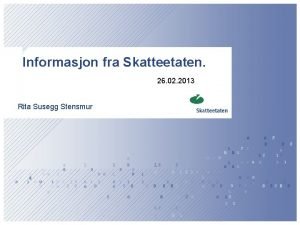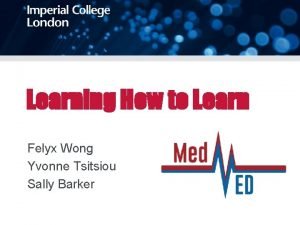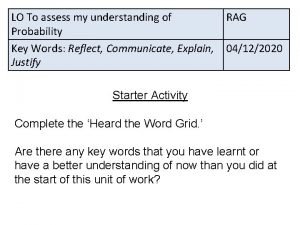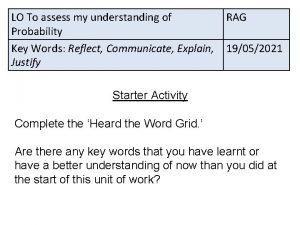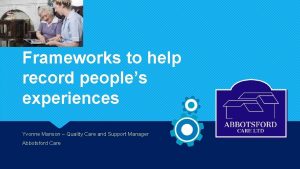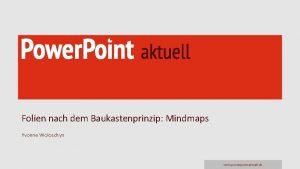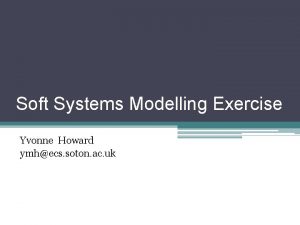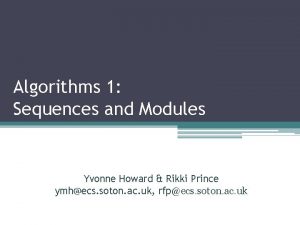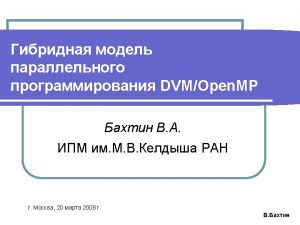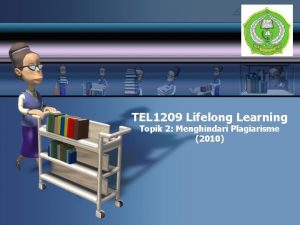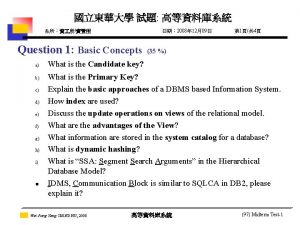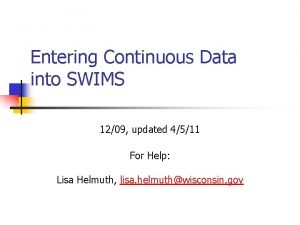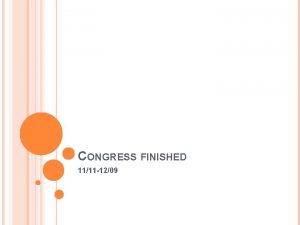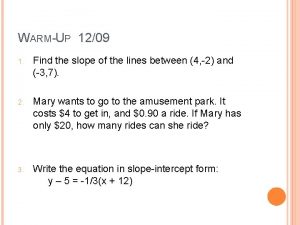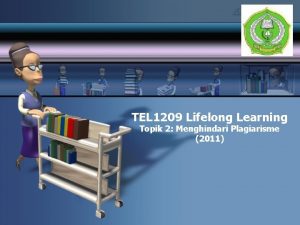Computational Systems COMP 1209 Testing Yvonne Howard ymhecs











































- Slides: 43

Computational Systems COMP 1209 Testing Yvonne Howard ymh@ecs. soton. ac. uk

A Problem A café wants to build an automated system to provide breakfasts. The robot waiter greets people before taking their order by name. Customers can order different combinations of ingredients for their meal, and also ask for one drink. The system then cooks the breakfast. It must be able to fry sausages, bacon, eggs and mushrooms; toast bread, waffles and muffins; and pour their orange juice or coffee. The waiter then serves the breakfast.

The all new Robo. Cafe Wa ere iter, ’s n wai t my o co er – cu ffee p in Th ***!! been I e v ’ I ter – days, all i a w o er, Wait ere for tw eakfast br gh sittin ant is my w W do aiter, n’t like waite toa my r – I ste eg gs d Waiter, waiter – I didn’t order 25 sausages Wa ite r, w ait e

So what went wrong and how can we have happiness café? ***!! Wa bre iter ak , wa he fast iter re’ s a is pe –this hu rfec ge t tip -

Software Engineering: Big Picture Requirements Gathering • Surveys • User studies • Focus groups • SSM Specification • UML • Use Cases • Scenarios • Storyboards Design • UML • Class Diagrams • Activity Diagrams • Sequence Diagrams • Etc… Implementation • Software code • APIs • Document formats Testing • Unit Tests • Black Box Tests • Etc… Deployment • Configuration • Bug Tracking • User Support This is rarely a straightforward progression – in reality there are lots of iterations and points of feedback

We can do some software engineering • Testing ▫ Used for most software systems • Or ▫ Formal verification �Build a model of the software �Use a prover to prove that the model is correct �Only a very small proportion of systems are verified this way, mostly safety critical systems • We’re going to talk about testing

. Cost of Change Curve ( Barry Boehm 1981) • The cost to address a defect rises exponentially the longer it takes you to find it. • if you inject a defect into your system and find it a few minutes later and fix it, the cost is almost negligible. • if you find it three months later the cost of fixing rises exponentially ▫ ▫ to fix the original problem to fix any work based on the defect

The Cost of Change Curve: Traditional versus Agile • Agile techniques have feedback cycles on the order of minutes or days, • Traditional techniques have long feedback cycles ( end of development) • Traditional strategies can be effective at finding defects but the cost of fixing them can be much higher

What are we testing for? Which of these might be valid? 1. Find bugs? 2. Try to break the software? 3. Reduce risk? 4. Check that performance is OK? 5. Prove the software is defect free? “Program testing can be used to show the presence of defects, but never their absence” Edgar Dijkstra

The goal of testing To increase to an acceptable level the user’s confidence that the system under test will behave correctly under all circumstances of interest • We have to define �Correct behaviour �Level of confidence � Domain of concern USER FOCUS

Correct behaviour • Bender takes Dave’s order for: ▫ 2 sausages, 1 fried egg, 2 slices of toast and a cup of coffee • Bender serves Dave his breakfast of: ▫ 2 sausages 1 fried egg, 2 slices of toast and a cup of coffee • Other issues (known as Non Functional requirements NFRs, ‘ilities) which describe Quality ▫ How long should Dave wait to order? ▫ Is burnt toast acceptable? ▫ Is the user experience/usability good enough? • You can build a defect free system that is unusable or has poor quality

Correct Behaviour • Definition of ‘correct behaviour’ required • Provided by a “Baseline” or “Blueprint” • Depends on level of testing Whole system – Requirements specification Increment – user stories One module – Program specification … and so on • Compare results of the test with what was supposed to happen • Test result – Pass or Fail

Level of Confidence • Usually specified as ‘residual defect discovery rate’ ▫ Number of defects found in a given test or series of tests, or • Number of defects found in a given time ▫ “Less than 10 non-critical defects discovered in last 7 days” • An alternative – Reliability specification ▫ “Mean time between failures shall be not less than 5000 hours” ▫ Difficult to determine until software goes “Live”

Tests are supposed to find errors A good test is focused to find errors A successful test finds new classes of errors • So how do we do good, successful, systematic testing? • Choose the right test method • Make test cases • A set of input values and expected outcomes for a software feature • Make a test plan • All the test cases necessary to test the software thoroughly • Follow good testing practice • Plan testing early (agile testers, write tests before code) • User focus, not designer or programmer • Use independent testing staff, not the people who designed or built the software ( except agile teams where testers and developers are interchangable)

When do we test? • During implementation ▫ Unit tests - For each module or submodule ▫ Integration tests - When you put modules together – ▫ Regression tests - When you change or add a component, to make sure that everything still works together • when you think you are ready to deliver ▫ Alpha – in house ▫ Beta - with your pals ▫ Acceptance – on official delivery

Two main types of testing • White box • Black Box

Structural (White Box) Testing • Uses knowledge of the program structure and algorithms • Construct test cases that will follow every path through the system ▫ Every statement in a method is executed at least once ▫ Every branch has been exercised for true/false conditions • This is very expensive and is usually done only for a small, critical part of the system

Black box testing inputs ? outputs Tests without reference to internal processing • Considers the correct behaviour of inputs and expected outputs • Uses techniques to reduce the amount of testing needed to satisfy correctness • Equivalence partitioning • Boundary value analysis

inputs ? outputs We are going to concentrate on black box testing

Strengths and weaknesses of Black Box Testing • Strengths ▫ More effective for larger units of code than glass box testing ▫ Tester needs no knowledge of implementation ▫ Tester and developer can be independent ▫ Test’s are from the user’s point of view ▫ Exposes ambiguities in the spec (but it’s a bit late in the game for that) ▫ Test cases can be designed early, from the specification • Weaknesses ▫ Only a small number of possible inputs can reasonably be tested ▫ Good test cases need clear specifications ▫ Some program paths will be untested ▫ Cannot target code directly

What is meant by a ‘test case’? • “A set of test inputs, execution conditions, and expected results developed for a particular objective, such as to exercise a particular program path or to verify compliance with a specific requirement” (IEEE standard) • “Input – processing – output” • Example (informal): Insert a card into an ATM (cash machine). The ATM reads the card and asks for the PIN • Inputs may include data and/or controls ▫ E. g. Numbers entered into a program ▫ E. g. Bank card inserted into ATM • The expected result is a statement of what the system should do – from the point of a satisfied customer

Test Cases Problem • A user ID consists of two characters < 1 alpha char> < 1 digit> ▫ The < 1 alpha char> consists of the characters A. . Z or a. . z ▫ < 1 digit> consists of the characters 0. . 9 • What test cases do you think that you might need to ensure that software processes a user ID correctly?

Some possible test cases - Test case System action Test data input 1 When the system asks for R 6 a user. ID Accept user ID and continue 2 When the system asks for xyz a user. ID Reject user. ID with error message ‘only 2 chars’ 3 When the system asks for 6 R a user. ID Reject user. ID with error 4 When the system asks for R% a user. ID Reject user. ID 5… … Pass criteria Pass/fail For a 2 char user. ID! – How can we stop the test case explosion?

Test Scenarios • Scenarios are sequences of test cases which represent a typical use of the system • Example of an ATM Scenario • Choice of Scenario has to take account of • Valid sequences (must work correctly) • Invalid sequences must produce correct error messages (and not proceed)

Where do we find our test cases and scenarios? • Test cases and scenarios need to explore ▫ Correct behaviour ▫ Error cases • Baseline (or blueprint) documents define correct behaviour, depending on the level of testing ▫ ▫ Requirements – System Test High level design – Integration Test Low level design – Unit Test Agile developers write tests before they write code • Test cases and scenarios are derived from the baseline documentation ▫ Large numbers are often required, determined by � Logical complexity – Unit test and Integration test � Number and nature of requirements – Higher test levels

How Many Tests? • A balance must be struck ▫ We want high quality - thorough testing ▫ We need to deliver the software – cannot go on testing for ever • We have to pick specific values to use in test cases ▫ Not enough time to test all possible values • Equivalence Partition Analysis helps to select a sensible number of test cases to run • Boundary Value Testing helps to choose values for those tests

Equivalence Partition Analysis • To reduce the number of test cases to a necessary minimum. ▫ Only one test case of each partition is needed to evaluate the behaviour of the program for the related partition. ▫ To use more or even all test cases of a partition will not find new faults in the program. ▫ The values within one partition are considered to be "equivalent". ▫ Thus the number of test cases can be reduced considerably • To select the right test cases to cover all possible behaviour ▫ you also find the so called "dirty" test cases. ▫ An inexperienced tester may be tempted to use as test cases the input data range and forget to select some out of the invalid partitions. ▫ This would lead to a huge number of unnecessary test cases on the one hand, and a lack of test cases for the dirty ranges on the other hand.

Equivalence Partition Analysis • Equivalence partitions are usually derived from the specification of the systems or component 's behaviour. ▫ consider �Input equivalence partitions �Output equivalence partitions • An input has values which are valid and other values which are invalid. ▫ These can be used to identify the equivalence partitions • If you had defined a function which has to pass the parameter "month" of a date. ▫ What are the valid and invalid values?

Equivalence partitions • The valid range for the month is 1 to 12, standing for January to December. ▫ This valid range is called a valid partition. • there are two partitions of invalid ranges. ▫ The first invalid partition would be <= 0 ▫ and the second invalid partition would be >= 13. . -2 -1 0 1. . . ……. . . . 12 13 14 15. . -------|-----------|----------Invalid partition 1 P 1 valid partitions Invalid partition 2

Equivalence Partitioning • Divide the domain of all possible inputs into classes of equivalent inputs • input conditions • Type of input condition Number of Valid equivalence classes needed Number of Invalid equivalence classes needed range 1 2 value 1 2 set 1 1 Boolean (true/false) 1 1 Construct one test case for each class

Equivalence Partitions – for value ranges • An input has certain ranges which are valid and other ranges which are invalid. • An example is the value range for the month parameter that we looked at earlier ▫ The valid range for the month is 1 to 12, standing for January to December. This is the valid partition ▫ There are 2 invalid ranges ▫ these are the invalid partitions: <= 0 and >= 13

Equivalence Partitions – for a set • Test particular input item matches a set of values ▫ If each case will be treated the same way �Identify one valid class for values in the set �and one invalid class representing values outside the set �E. g valid course codes for semester 1 are: (COMP 1209, COMP 1202, COMP 1216, COMP 1201) Valid class: code is one of (COMP 1209, COMP 1202, COMP 1216, COMP 1201) Invalid class: code not one of (COMP 1209, COMP 1202, COMP 1216, COMP 1201) ▫ If each case will be treated differently, Identify: � one valid equivalence class for each element and � one invalid equivalence class for values outside the set �E. g valid boat codes are (catamaran, dinghy, rib) �Valid class is catamaran �Valid class is dinghy �Valid class is rib �Invalid class is not one of (catamaran, dinghy, rib)

Boundary Value Analysis - Selecting Values for Test Data for each Equivalence Class • Once equivalence classes (partitions) are identified, we can think about test data values ▫ We need some values that fall into each class • Select values at the boundaries and somewhere in the middle of each class ▫ This called Boundary Value Analysis ▫ If these data points produce correct results, it is fairly safe to assume that other values will also be correctly processed • NOTE: Correct operation at the other points is not guaranteed but we have to find sensible ways to limit testing

Boundary Value Analysis • Using the domain of all possible inputs and outputs • Divide the domain into valid and invalid classes • For each boundary: construct test cases with these inputs Test case Inputs 1 Boundary value as input 2 Slightly less than boundary value 3 Slightly less than boundary value

Test plan for a student enrolment system A student enrolment system: • the system accepts students between 16 and 99 years of age • Find the equivalence partitions • Use boundary value analysis to identify values for your test cases Equivalence class value (age) Expected result Pass/f (message) ail

Using Equivalence Partitioning & Boundary Value Analysis for the user. ID problem • Going back to our first example: A user ID consists of two characters < 1 alpha char> < 1 digit> ▫ The < 1 alpha char> consists of the characters A. . Z or a. . z ▫ < 1 digit> consists of the characters 0. . 9 • What test cases do you think that you might need to ensure that software processes a user ID correctly - using equivalence partitioning (and boundary value analysis? )

Loan Interest calculator example

Equivalence Partitions Build a table for your equivalence classes: showing inputs and expected outputs

Selecting Values – Valid Partition

Selecting Values – Interest Error

Summary • Test cases are the smallest steps • Test cases are assembled into scenarios ▫ Represent a typical usage of the system • Equivalence Partitioning ▫ Used to find groups of inputs / outputs that produce similar behaviour • Boundary Value Analysis ▫ Used to select values for each equivalence partition

Happiness café? ***!! Wa bre iter ak , wa he fast iter re’ s a is pe –this hu rfec ge t tip -

Oh for crying out loud. I never wanted to be a dev anyway. What I *really* want is to be a. . . tester! I'm a tester and I'm okay, I sleep all night and I work all day. (He's a tester and he's okay, he sleeps all night and he works all day. ) I look for bugs, I log those bugs, I do it all with glee. And the really good ones, I show off repeatedly. (He looks for bugs, he logs those bugs, he does it all with glee. And the really good ones, he shows off repeatedly. ) I'm a tester and I'm okay, I sleep all night and I work all day. (He's a tester and he's okay, he sleeps all night and he works all day. ) I pester PMs, I pester devs, I make them despair and cry. I know I've done my job, when I hear them wail "Why oh why? " (He pesters PMs, he pesters devs, he makes them despair and cry. He knows he's done his job, when he hears them wail "Why oh why? ") I'm a tester and I'm okay, I sleep all night and I work all day. (He's a tester and he's okay, he sleeps all night and he works all day. ) I black box test, I white box test, I write docs and PR too. I wish I was in marketing, 'cause then I'd rule the roost. (He black box tests, he white box tests, he writes docs? and PR too? ? He wishes he was in marketing? ? ? Where's my Nerf gun? Get him!!!) [The dev runs out, chased by the backup singers who continue to sing: ] He's a tester and he's okay, he sleeps all night and he works all day. He's a tester and he's okaaaaaaaaay. . . he sleeps all night and he works all day. The braidy tester http: //www. thebraidytester. com/blogs. html
 Rf-1209 po polsku
Rf-1209 po polsku Domain testing example
Domain testing example Logic based testing in software testing
Logic based testing in software testing Data flow testing strategies in software testing
Data flow testing strategies in software testing Positive and negative testing
Positive and negative testing Cs3250
Cs3250 Localization globalization testing
Localization globalization testing Functional testing vs unit testing
Functional testing vs unit testing Cause effect graph for triangle problem
Cause effect graph for triangle problem Control structure testing in software engineering
Control structure testing in software engineering Decision table testing in software testing
Decision table testing in software testing Decision table technique
Decision table technique Metode black box
Metode black box Black-box testing disebut juga sebagai behavioral testing
Black-box testing disebut juga sebagai behavioral testing Decision table testing
Decision table testing Rigorous testing in software testing
Rigorous testing in software testing Testing blindness in software testing
Testing blindness in software testing Component testing is a black box testing
Component testing is a black box testing Software domain examples
Software domain examples Yvonne fulmore
Yvonne fulmore Yvonne van kemenade
Yvonne van kemenade Yvonne blue
Yvonne blue Yvonne genovese
Yvonne genovese Yvonne ber
Yvonne ber Marcel pagnol épouse
Marcel pagnol épouse Yvonne stolk
Yvonne stolk Yvonne philips
Yvonne philips Yvonne reisner
Yvonne reisner Yvonne wijnands
Yvonne wijnands Yvonne van ballegooijen
Yvonne van ballegooijen Christiane moser
Christiane moser Yvonne dolan
Yvonne dolan Yvonne flack
Yvonne flack Clive wants to estimate the number of bees in a beehive
Clive wants to estimate the number of bees in a beehive Yvonne jackson therapist
Yvonne jackson therapist Yvonne fulmore
Yvonne fulmore Yvonne delaney
Yvonne delaney Mla citation poem
Mla citation poem Yvonne has 10 tulip bulbs in a bag
Yvonne has 10 tulip bulbs in a bag Yvonne hung
Yvonne hung Yvonne manson
Yvonne manson Yvonne woloschyn
Yvonne woloschyn Yvonne seitz
Yvonne seitz B. f. skinner yvonne blue
B. f. skinner yvonne blue
